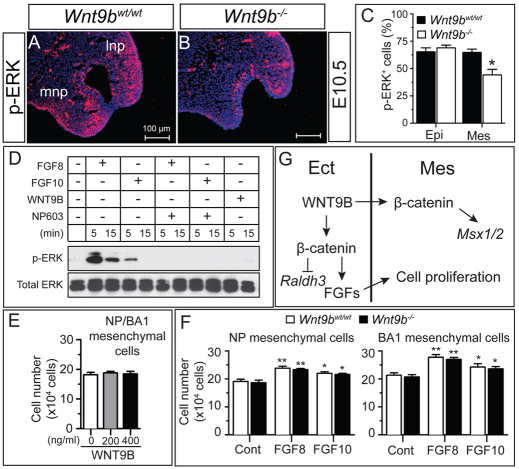Fig. 8.
Increased cell proliferation and ERK1/2 phosphorylation by FGFs in facial process mesenchymal cells. (A-C) Reduced ERK1/2 phosphorylation in the NP of Wnt9b–/– mouse embryos. Immunostained images (A,B) and their quantitation (C) are presented. (D) Activation of ERK1/2 phosphorylation by FGF8 and FGF10. The upper facial mesenchymal cells were stimulated with FGFs or WNT9B for 5 or 15 minutes. NP603 (5 μM) was added to the cells simultaneously with FGFs. Total and phosphorylated ERK1/2 protein levels were analyzed by western blot. (E,F) Mesenchymal cell proliferation was enhanced by FGF8 and FGF10 but not WNT9B. Mesenchymal cells isolated from the wild-type or Wnt9b–/– NP/MxP explants were cultured in the presence of FGFs or WNT9B for 3 days. Total cell numbers were counted. Mean±s.e.m. *P<0.05, **P<0.01, Student’s t-test. (G) Model for WNT9B function in upper facial development. The facial ectoderm-derived WNT9B regulates the FGF family genes and Raldh3 in ectoderm and the Msx1/2 genes in mesenchyme in a β-catenin-dependent manner. Cell proliferation within mesenchyme is directly regulated by WNT9B-induced FGFs. Epi, epithelium; Ect, surface ectoderm; Mes, mesenchyme; lnp, lateral nasal process; mnp, medial nasal process.

